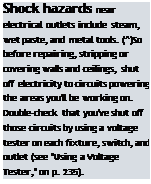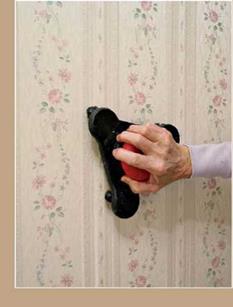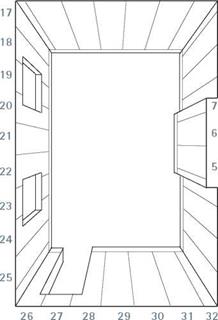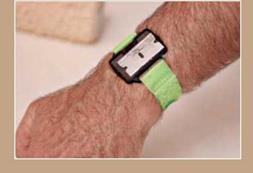PREPPING PAINTED SURFACES
Before you wallpaper painted surfaces, figure out what kind of paint you’ve got and what shape it’s in. In general, oil-based paints are stable surfaces for wallcovering because they aren’t water soluble. Yet some primer-sealers can stabilize even latex paint. You could scrape off a small patch of paint and have a paint store analyze it, but two simple tests should suffice.
Hot towel test. Soak a hand towel in hot water, wring it well, and then rub the paint vigorously for 20 seconds to 30 seconds. If paint comes off on the towel, you’ve probably got latex. Alternatively, you can use duct tape to hold a moist sponge next to a painted surface for 15 minutes before removing the sponge. If you see paint on the sponge, it’s latex.
LOOKING Sharp
This clever magnetic bracelet keeps a singleedge razor blade handy. A sharp blade is essential, especially if you’re working with prepasted wallcoverings soaked in water. Wetted paper will snag a dull blade and rip easily. Blades are far cheaper than wasted wallcovering.
|
|
X-tape test. If paint didn’t come off on your towel or sponge, it’s probably oil based. To see how well it’s adhered, use a razor blade to lightly score a 1-in. Xin the paint surface (don’t cut into the drywall or plaster). Press masking tape over the X, and then pull it off quickly: If there’s no paint on the tape, the paint is well adhered.
If paint does come off, scrape and sand it well before proceeding.
If the existing paint is well-adhered glossy or semigloss oil-based, sand it lightly with fine sandpaper, using a sanding block or an orbital sander. Then use a sponge mop, dampened with water, to remove the sanding dust. Or, instead of sanding, you can spray or wipe on paint deglosser to dull glossy and semigloss paint surfaces.
If the paint is well-adhered flat oil-based paint, you can begin hanging wallcovering. Simply rinse the surface with a mild detergent solution to remove grime, rinse with clear water, and allow to dry.
![]()

![]()
 Latex paint should be prepared by scraping lightly and sanding. You needn’t remove the entire coat of paint; just sand it enough so the primer-sealer can bond. Avoid gouging or ripping the surface underneath, especially if it’s drywall. When you’re done sanding, wipe the wall clean and apply a coat of pigmented acrylic primer-sealer.
Latex paint should be prepared by scraping lightly and sanding. You needn’t remove the entire coat of paint; just sand it enough so the primer-sealer can bond. Avoid gouging or ripping the surface underneath, especially if it’s drywall. When you’re done sanding, wipe the wall clean and apply a coat of pigmented acrylic primer-sealer.


![]()


You can wallpaper over an existing covering if:
► It is not highly textured, as lincrusta, stringcloth, and bamboo are.
► There are no prominent seams.
► There’s no more than one or two layers already on the wall.
► The old wallpaper is well adhered.
Check edges and seams first: If they’re peeling
or poorly adhered, strip the walllcovering. But if there are only a few isolated unadhered spots, use seam adhesive to reattach them. Or use a razor blade to cut out the loose seams. Then fill voids with spackling compound, allow it to dry, and sand it lightly with 180-grit or 220-grit sandpaper.
Another potential problem is bleed-through from metallic wallpaper inks. To test, dampen a cloth with diluted ammonia (1 part ammonia to 4 parts water) and rub the old wallpaper.
If inks change color (usually, they turn blue – green), they’ll bleed. To prevent this, seal the old wallpaper with pigmented shellac or a similar stain killer. Allow the sealer to dry thoroughly before painting surfaces with a universal primer-sealer.
Otherwise, if existing wallpaper is well adhered, wipe it with a damp sponge, let it dry, and then paint surfaces with pigmented acrylic primer-sealer. Tint the primer-sealer to match the background color of the new wallcovering.
Some pros recommend using a scarifying tool, such as Paper Tiger®, to perforate wallpaper so steam can penetrate. But such tools can also perforate drywall and scar its surface. Damage can also occur if you use metal-edged scrapers. So use such tools only as a last resort when the paste is especially tenacious, and use them with great care. Instead, try steaming the wallpaper, before scarifying or scraping it.
Strip existing wallcovering if it is tired or grimy and can’t be washed, poorly adhered or damaged, puckered or lumpy because there are too many layers, water stained or damaged, moldy, strongly textured, or you want to paint the walls instead. Before you apply new wallcovering, repair and prime the finish surfaces.
Before stripping, reconnoiter. Peel up a corner of the wallpaper in an out-of-the-way place. Then determine whether the walls are plaster or dry- wall. Plaster is harder and can survive a lot more steaming and scraping than drywall. Next, test how easily the wallpaper strips. Peelable and strip – pable types should be relatively easy to remove if the wall was properly sealed before it was papered. But if surfaces were not sized or primed first, you’re in for some work. Moreover, if the unsealed substrate is drywall, stripping the wallpaper may destroy the paper face of the drywall. In theory, you can patch and then seal damaged drywall with products like Allpro Seal ‘n Bond®; but removing the damaged drywall, or covering it with 14-in. drywall will yield far better results.
|
|
||
|
|||



Stripping wallpaper is messy, no matter what method you use. You’ll need painters’ tarps or old towels to protect floors from stripping solutions, condensed steam, and sticky wallpaper. Canvas tarps, or even old towels, are better than plastic tarps, which tend to be slippery. Have trash bags handy for stripped paper. О As noted earlier, turn off the electricity to areas you’re stripping, and use a voltage tester to be sure the power’s off.
Use the least disruptive stripping method.
Start stripping at the top or bottom of a strip. Use a putty knife or a plastic scraper to lift an edge. Then gently pull off the wallpaper, in the largest strips possible. This takes patience.
If you can’t pull off the covering or if it begins tearing into small pieces, try spraying a small area with a wallpaper-removing solution like Zinsser’s DIF®, which is also available as a gel, that you brush on. A time-tested alternative is 1 cup vinegar per gallon of hot water; sponge on or apply with a spray bottle. Allow either solution to soak in 5 minutes to 10 minutes, before trying to pull off the paper. If this method doesn’t work, chances are the paper is vinyl coated and the solution is not penetrating. In this case, instead
try a wallpaper steamer. Hold the steamer pan against the wallcovering long enough for the paste to soften—usually a minute or two—then pull or scrape the covering free.
If your wallcovering is peelable, chances are its facing layer will strip off, leaving its paper backing adhered to the wall. If you wish to strip it, either spray on or sponge on wallpaper – removing solution, and then apply steam. The backing should release easily; otherwise, use a plastic scraper or smoother to remove the backing. When the walls are stripped, wash them with a mild cleaning solution. Then rinse and let them


![]()
![]()
![]()

dry thoroughly before applying a primer-sealer. If paste lumps remain, remove them with a nylon-bristle scrub brush.







Leave a reply